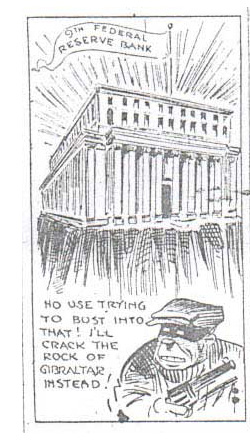Had to do some banking today to tidy up loose ends on my Dad’s estate, and that meant going to a different bank than the one I use, and trying to get money out. It was easily done, because all the requisite forms were on file - but there was a nagging itch at the back of my head, once I’ve had for a while.
What if it’s all gone?
What if the banker calls up the account and frowns, and says “there doesn’t seem to be anything here,” or can’t find the account at all?
It’s ridiculous, I know; I’ve been getting statements from the estate account, but the last was a month ago. WHAT IF HACKERS GOT IT
Completely absurd, but on the other hand, there’s just a few strings of numbers anyone needs to get in. Probably a password. Seems too simple. I’m sure there’s more to it, and someone can’t just get your account numbers and drain you dry, but
I WANT IT ALL IN A BANK BEHIND A CIRCULAR LOCKED DOOR TWO FEET THICK, is what I’m saying.
When I was a kid the banks downtown were serious sober structures, and you knew they had vaults, with guards, who had guns. Sure, the Penguin could waddle along and shoot some gas out of his umbrella and then command his Fine Feathered Fiends to open the vault, but that probably wouldn’t happen in Fargo.
I didn’t even trust Gate City, because it was a Savings and Loan. What’s that? It’s a bank. A type of bank. Why don’t they call themselves a bank, then? It’s not a bank. It almost seemed as if they were up to something shifty. We're totally a bank for reals! We just . . . don't call ourselves that.
So the money was put in a new account, and I got pieces of paper in return, and have to trust that it all actually happened.
The first bank I went to was in the burbs, in a building that marked the renaissance of the near-western downtown-adjacent area. I’d never been inside, only seen its cartoony post-modernism from a distance.
Behold: 1988.
Does any of that spell BANK to you? No. It is perfectly acceptable for a mortgage loan company, though; for those places, we expect atriums and running water, because that's different. Mortgage outfits are not expected to have huge amounts of cash on hand in a vault guarded by doughy yet stern-faced guards who probably did a stint at San Q and learned how to size up a troublemaker.
A few years ago I got to visit the old Federal Reserve vault. It had a cage with gun ports. I want my money behind gun ports.
These round objects engaged with holes in the wall to assure security:
| |
|
|
 |
|
From a newspaper story about the building's completion.
No one ever did crack it. No one even tried.
Right now, I'm sure, my bank is fending off 34,396 attempts to hack it. |
 |
|
|
But like I said, I'm unschooled and paranoid. I also like cash. Don't carry it; don't hoard it. But knowing there's a twenty folded in my thin wallet full of cards is a comfort. The cards could be declined, for whatever hideous reason.
Cash always works.
Everyone loves cash. Admit it. Cash rules.
|